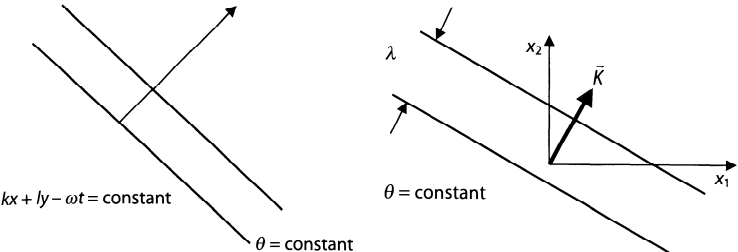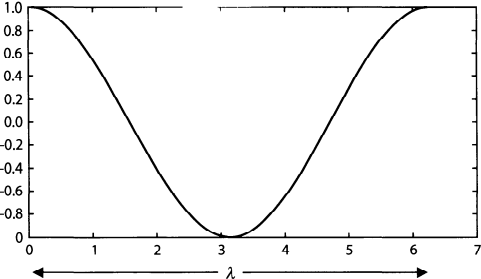The function \( \phi \) we have considered above is constant on the surface where \( \theta \) is constant, i.e.,
\(
k_i x_i - \omega t = \text{constant}
\)
In two dimensions these are the lines
\(
\vec{K} \cdot \vec{x} - \omega t = k_1 x_1 + k_2 x_2 - \omega t \equiv kx + ly - \omega t
\)
(\( k_1 = k, k_2 = l, k_3 = m \) in Cartesian coordinates)

The directions of the lines of constant phase are given by the normal to those lines of constant \( \theta \) \[ \nabla \theta = \nabla (\vec{K} \cdot \vec{x} - \omega t) = \vec{K} \] or equivalently \[ \frac{\partial \theta}{\partial x_i} = \frac{\partial}{\partial x_i} (k_j x_j - \omega t) = k_j \frac{\partial x_j}{\partial x_i} = k_j \delta_{ij} = k_i \]
Define \(K = |\vec{K}|\) (the magnitude of the wave vector) \(\Rightarrow \boxed{\vec{K} \cdot \vec{x} = Ks}\) where \( s \) is the scalar distance perpendicular to the line of constant phase (e.g., where \( \phi \) reaches a maximum)
The plane wave is a spatially periodic function, so
\(
\phi(Ks) = \phi(K[s+\lambda])
\)
where \( K \lambda = 2\pi \)

Because
\(
e^{i(Ks)} = e^{i(Ks + 2\pi)}, \quad e^{i(2\pi)} \equiv 1
\)
The wavelength \( \lambda \) is
\(
\lambda = \frac{2\pi}{K}
\), it is the distance along the wave vector between two points of the
same phase
1 Pedlosky, Joseph. (2003). Waves in the Ocean and Atmosphere: Introduction to Wave Dynamics. Springer-Verlag, Heidelberg and New York.